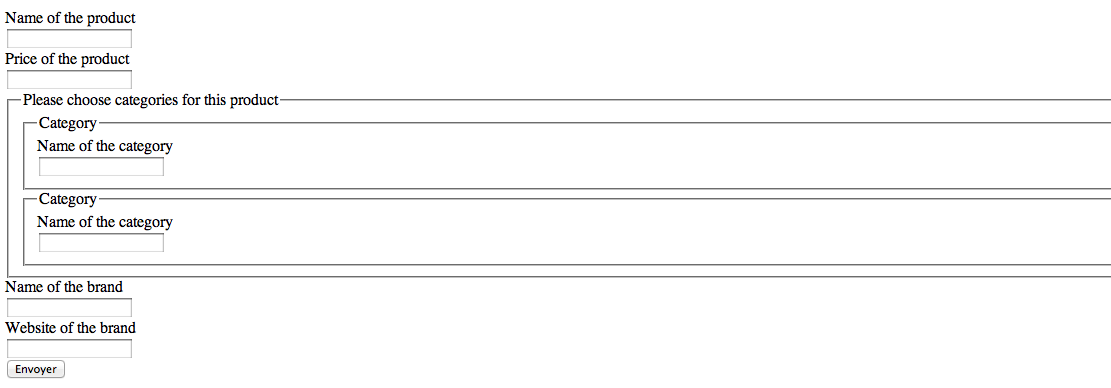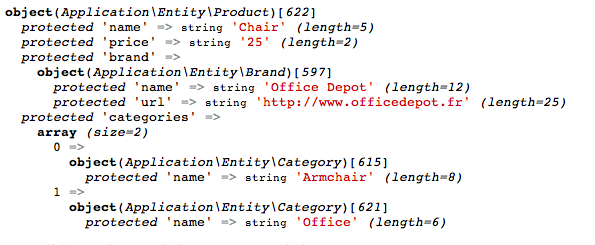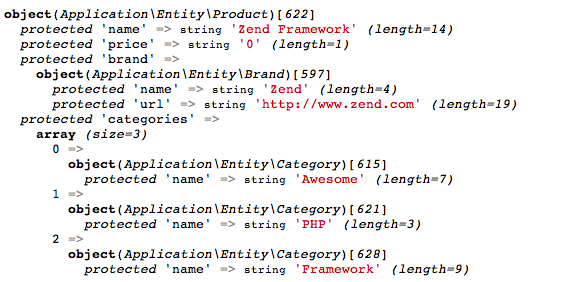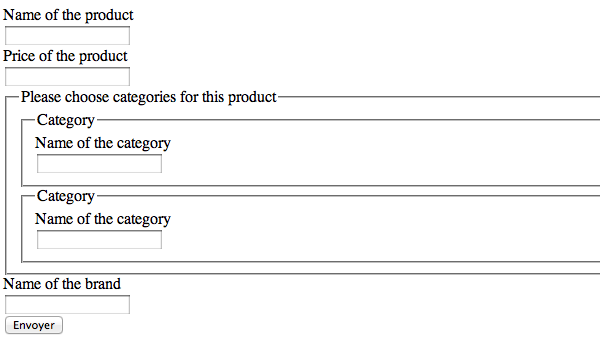Form Collections¶
Often, fieldsets or elements in your forms will correspond to other domain objects. In some cases, they may correspond to collections of domain objects. In this latter case, in terms of user interfaces, you may want to add items dynamically in the user interface – a great example is adding tasks to a task list.
This document is intended to demonstrate these features. To do so, we first need to define some domain objects that we’ll be using.
1 2 3 4 5 6 7 8 9 10 11 12 13 14 15 16 17 18 19 20 21 22 23 24 25 26 27 28 29 30 31 32 33 34 35 36 37 38 39 40 41 42 43 44 45 46 47 48 49 50 51 52 53 54 55 56 57 58 59 60 61 62 63 64 65 66 67 68 69 70 71 72 73 74 75 76 77 78 79 80 81 82 83 84 85 86 87 88 89 90 91 92 93 94 95 96 97 98 99 100 101 102 103 104 105 106 107 108 109 110 111 112 113 114 115 116 117 118 119 120 121 122 123 124 125 126 127 128 129 130 131 132 133 134 135 136 137 138 139 140 141 142 143 144 145 146 147 148 149 150 151 152 153 154 155 156 157 158 159 160 161 162 163 164 165 166 167 168 169 170 171 | namespace Application\Entity;
class Product
{
/**
* @var string
*/
protected $name;
/**
* @var int
*/
protected $price;
/**
* @var Brand
*/
protected $brand;
/**
* @var array
*/
protected $categories;
/**
* @param string $name
* @return Product
*/
public function setName($name)
{
$this->name = $name;
return $this;
}
/**
* @return string
*/
public function getName()
{
return $this->name;
}
/**
* @param int $price
* @return Product
*/
public function setPrice($price)
{
$this->price = $price;
return $this;
}
/**
* @return int
*/
public function getPrice()
{
return $this->price;
}
/**
* @param Brand $brand
* @return Product
*/
public function setBrand(Brand $brand)
{
$this->brand = $brand;
return $this;
}
/**
* @return Brand
*/
public function getBrand()
{
return $this->brand;
}
/**
* @param array $categories
* @return Product
*/
public function setCategories(array $categories)
{
$this->categories = $categories;
return $this;
}
/**
* @return array
*/
public function getCategories()
{
return $this->categories;
}
}
class Brand
{
/**
* @var string
*/
protected $name;
/**
* @var string
*/
protected $url;
/**
* @param string $name
* @return Brand
*/
public function setName($name)
{
$this->name = $name;
return $this;
}
/**
* @return string
*/
public function getName()
{
return $this->name;
}
/**
* @param string $url
* @return Brand
*/
public function setUrl($url)
{
$this->url = $url;
return $this;
}
/**
* @return string
*/
public function getUrl()
{
return $this->url;
}
}
class Category
{
/**
* @var string
*/
protected $name;
/**
* @param string $name
* @return Category
*/
public function setName($name)
{
$this->name = $name;
return $this;
}
/**
* @return string
*/
public function getName()
{
return $this->name;
}
}
|
As you can see, this is really simple code. A Product has two scalar properties (name and price), a OneToOne relationship (one product has one brand), and a OneToMany relationship (one product has many categories).
Creating Fieldsets¶
The first step is to create three fieldsets. Each fieldset will contain all the fields and relationships for a specific entity.
Here is the Brand fieldset:
1 2 3 4 5 6 7 8 9 10 11 12 13 14 15 16 17 18 19 20 21 22 23 24 25 26 27 28 29 30 31 32 33 34 35 36 37 38 39 40 41 42 43 44 45 46 47 48 49 50 51 52 | namespace Application\Form;
use Application\Entity\Brand;
use Zend\Form\Fieldset;
use Zend\InputFilter\InputFilterProviderInterface;
use Zend\Stdlib\Hydrator\ClassMethods as ClassMethodsHydrator;
class BrandFieldset extends Fieldset implements InputFilterProviderInterface
{
public function __construct()
{
parent::__construct('brand');
$this
->setHydrator(new ClassMethodsHydrator(false))
->setObject(new Brand())
;
$this->add(array(
'name' => 'name',
'options' => array(
'label' => 'Name of the brand',
),
'attributes' => array(
'required' => 'required',
),
));
$this->add(array(
'name' => 'url',
'type' => 'Zend\Form\Element\Url',
'options' => array(
'label' => 'Website of the brand',
),
'attributes' => array(
'required' => 'required',
),
));
}
/**
* @return array
*/
public function getInputFilterSpecification()
{
return array(
'name' => array(
'required' => true,
),
);
}
}
|
We can discover some new things here. As you can see, the fieldset calls the
method setHydrator(), giving it a ClassMethods hydrator, and the
setObject() method, giving it an empty instance of a concrete Brand
object.
When the data will be validated, the Form will automatically iterate through
all the field sets it contains, and automatically populate the sub-objects, in
order to return a complete entity.
Also notice that the Url element has a type of Zend\Form\Element\Url.
This information will be used to validate the input field. You don’t need to
manually add filters or validators for this input as that element provides a
reasonable input specification.
Finally, getInputFilterSpecification() gives the specification for the remaining
input (“name”), indicating that this input is required. Note that required in
the array “attributes” (when elements are added) is only meant to add the
“required” attribute to the form markup (and therefore has semantic meaning
only).
Here is the Category fieldset:
1 2 3 4 5 6 7 8 9 10 11 12 13 14 15 16 17 18 19 20 21 22 23 24 25 26 27 28 29 30 31 32 33 34 35 36 37 38 39 40 41 42 43 | namespace Application\Form;
use Application\Entity\Category;
use Zend\Form\Fieldset;
use Zend\InputFilter\InputFilterProviderInterface;
use Zend\Stdlib\Hydrator\ClassMethods as ClassMethodsHydrator;
class CategoryFieldset extends Fieldset implements InputFilterProviderInterface
{
public function __construct()
{
parent::__construct('category');
$this
->setHydrator(new ClassMethodsHydrator(false))
->setObject(new Category())
;
$this->setLabel('Category');
$this->add(array(
'name' => 'name',
'options' => array(
'label' => 'Name of the category',
),
'attributes' => array(
'required' => 'required',
),
));
}
/**
* @return array
*/
public function getInputFilterSpecification()
{
return array(
'name' => array(
'required' => true,
),
);
}
}
|
Nothing new here.
And finally the Product fieldset:
1 2 3 4 5 6 7 8 9 10 11 12 13 14 15 16 17 18 19 20 21 22 23 24 25 26 27 28 29 30 31 32 33 34 35 36 37 38 39 40 41 42 43 44 45 46 47 48 49 50 51 52 53 54 55 56 57 58 59 60 61 62 63 64 65 66 67 68 69 70 71 72 73 74 75 76 77 78 79 80 81 82 83 84 | namespace Application\Form;
use Application\Entity\Product;
use Zend\Form\Fieldset;
use Zend\InputFilter\InputFilterProviderInterface;
use Zend\Stdlib\Hydrator\ClassMethods as ClassMethodsHydrator;
class ProductFieldset extends Fieldset implements InputFilterProviderInterface
{
public function __construct()
{
parent::__construct('product');
$this
->setHydrator(new ClassMethodsHydrator(false))
->setObject(new Product())
;
$this->add(array(
'name' => 'name',
'options' => array(
'label' => 'Name of the product',
),
'attributes' => array(
'required' => 'required',
),
));
$this->add(array(
'name' => 'price',
'options' => array(
'label' => 'Price of the product',
),
'attributes' => array(
'required' => 'required',
),
));
$this->add(array(
'type' => 'Application\Form\BrandFieldset',
'name' => 'brand',
'options' => array(
'label' => 'Brand of the product',
),
));
$this->add(array(
'type' => 'Zend\Form\Element\Collection',
'name' => 'categories',
'options' => array(
'label' => 'Please choose categories for this product',
'count' => 2,
'should_create_template' => true,
'allow_add' => true,
'target_element' => array(
'type' => 'Application\Form\CategoryFieldset',
),
),
));
}
/**
* Should return an array specification compatible with
* {@link Zend\InputFilter\Factory::createInputFilter()}.
*
* @return array
*/
public function getInputFilterSpecification()
{
return array(
'name' => array(
'required' => true,
),
'price' => array(
'required' => true,
'validators' => array(
array(
'name' => 'Float',
),
),
),
);
}
}
|
We have a lot of new things here!
First, notice how the brand element is added: we specify it to be of type
Application\Form\BrandFieldset. This is how you handle a OneToOne
relationship. When the form is validated, the BrandFieldset will first be
populated, and will return a Brand entity (as we have specified a
ClassMethods hydrator, and bound the fieldset to a Brand entity using
the setObject() method). This Brand entity will then be used to populate
the Product entity by calling the setBrand() method.
The next element shows you how to handle OneToMany relationship. The type is
Zend\Form\Element\Collection, which is a specialized element to handle such
cases. As you can see, the name of the element (“categories”) perfectly matches
the name of the property in the Product entity.
This element has a few interesting options:
count: this is how many times the element (in this case a category) has to be rendered. We’ve set it to two in this examples.should_create_template: if set totrue, it will generate a template markup in a<span>element, in order to simplify adding new element on the fly (we will speak about this one later).allow_add: if set totrue(which is the default), dynamically added elements will be retrieved and validated; otherwise, they will be completely ignored. This, of course, depends on what you want to do.target_element: this is either an element or, as this is the case in this example, an array that describes the element or fieldset that will be used in the collection. In this case, thetarget_elementis aCategoryfieldset.
The Form Element¶
So far, so good. We now have our field sets in place. But those are field sets,
not forms. And only Form instances can be validated. So here is the form :
1 2 3 4 5 6 7 8 9 10 11 12 13 14 15 16 17 18 19 20 21 22 23 24 25 26 27 28 29 30 31 32 33 34 35 36 37 38 39 | namespace Application\Form;
use Zend\Form\Form;
use Zend\InputFilter\InputFilter;
use Zend\Stdlib\Hydrator\ClassMethods as ClassMethodsHydrator;
class CreateProduct extends Form
{
public function __construct()
{
parent::__construct('create_product');
$this
->setAttribute('method', 'post')
->setHydrator(new ClassMethodsHydrator(false))
->setInputFilter(new InputFilter())
;
$this->add(array(
'type' => 'Application\Form\ProductFieldset',
'options' => array(
'use_as_base_fieldset' => true,
),
));
$this->add(array(
'type' => 'Zend\Form\Element\Csrf',
'name' => 'csrf',
));
$this->add(array(
'name' => 'submit',
'attributes' => array(
'type' => 'submit',
'value' => 'Send',
),
));
}
}
|
CreateProduct is quite simple, as it only defines a Product fieldset, as
well as some other useful fields (CSRF for security, and a Submit button).
Notice the use_as_base_fieldset option. This option is here to say to the form:
“hey, the object I bind to you is, in fact, bound to the fieldset that is the
base fieldset.” This will be to true most of the times.
What’s cool with this approach is that each entity can have its own Fieldset and
can be reused. You describe the elements, the filters, and validators for each
entity only once, and the concrete Form instance will only compose those
fieldsets. You no longer have to add the “username” input to every form that
deals with users!
The Controller¶
Now, let’s create the action in the controller:
1 2 3 4 5 6 7 8 9 10 11 12 13 14 15 16 17 18 19 20 21 22 | /**
* @return array
*/
public function indexAction()
{
$form = new CreateProduct();
$product = new Product();
$form->bind($product);
$request = $this->getRequest();
if ($request->isPost()) {
$form->setData($request->getPost());
if ($form->isValid()) {
var_dump($product);
}
}
return array(
'form' => $form,
);
}
|
This is super easy. Nothing to do in the controllers. All the magic is done behind the scene.
The View¶
And finally, the view:
1 2 3 4 5 6 7 8 9 10 11 12 13 14 15 16 17 18 19 20 21 | <?php
$form->setAttribute('action', $this->url('home'))
->prepare();
echo $this->form()->openTag($form);
$product = $form->get('product');
echo $this->formRow($product->get('name'));
echo $this->formRow($product->get('price'));
echo $this->formCollection($product->get('categories'));
$brand = $product->get('brand');
echo $this->formRow($brand->get('name'));
echo $this->formRow($brand->get('url'));
echo $this->formHidden($form->get('csrf'));
echo $this->formElement($form->get('submit'));
echo $this->form()->closeTag();
|
A few new things here :
- the
prepare()method. You must call it prior to rendering anything in the view (this function is only meant to be called in views, not in controllers). - the
FormRowhelper renders a label (if present), the input itself, and errors. - the
FormCollectionhelper will iterate through every element in the collection, and render every element with the FormRow helper (you may specify an alternate helper if desired, using thesetElementHelper()method on thatFormCollectionhelper instance). If you need more control about the way you render your forms, you can iterate through the elements in the collection, and render them manually one by one.
Here is the result:

As you can see, collections are wrapped inside a fieldset, and every item in the
collection is itself wrapped in the fieldset. In fact, the Collection
element uses label for each item in the collection, while the label of the
Collection element itself is used as the legend of the fieldset. You must have
a label on every element in order to use this feature. If you don’t want the fieldset
created, but just the elements within it, simply add a boolean false as the second
parameter of the FormCollection view helper.
If you validate, all elements will show errors (this is normal, as we’ve marked them as required). As soon as the form is valid, this is what we get :

As you can see, the bound object is completely filled, not with arrays, but with objects!
But that’s not all.
Adding New Elements Dynamically¶
Remember the should_create_template? We are going to use it now.
Often, forms are not completely static. In our case, let’s say that we don’t
want only two categories, but we want the user to be able to add other ones at
runtime. Zend\Form has this capability. First, let’s see what it generates
when we ask it to create a template:

As you can see, the collection generates two fieldsets (the two categories)
plus a span with a data-template attribute that contains the full HTML
code to copy to create a new element in the collection. Of course __index__
(this is the placeholder generated) has to be changed to a valid value.
Currently, we have
2 elements (categories[0] and categories[1], so __index__ has to be
changed to 2.
If you want, this placeholder (__index__ is the default) can be changed using
the template_placeholder option key:
1 2 3 4 5 6 7 8 9 10 11 12 13 | $this->add(array(
'type' => 'Zend\Form\Element\Collection',
'name' => 'categories',
'options' => array(
'label' => 'Please choose categories for this product',
'count' => 2,
'should_create_template' => true,
'template_placeholder' => '__placeholder__',
'target_element' => array(
'type' => 'Application\Form\CategoryFieldset',
),
),
));
|
First, let’s add a small button “Add new category” anywhere in the form:
1 | <button onclick="return add_category()">Add a new category</button>
|
The add_category function is fairly simple:
- First, count the number of elements we already have.
- Get the template from the
span’sdata-templateattribute. - Change the placeholder to a valid index.
- Add the element to the DOM.
Here is the code:
1 2 3 4 5 6 7 8 9 10 11 | <script>
function add_category() {
var currentCount = $('form > fieldset > fieldset').length;
var template = $('form > fieldset > span').data('template');
template = template.replace(/__index__/g, currentCount);
$('form > fieldset').append(template);
return false;
}
</script>
|
(Note: the above example assumes $() is defined, and equivalent to jQuery’s
$() function, Dojo’s dojo.query, etc.)
One small remark about the template.replace: the example uses
currentCount and not currentCount + 1, as the indices are zero-based
(so, if we have two elements in the collection, the third one will have the
index 2).
Now, if we validate the form, it will automatically take into account this new element by validating it, filtering it and retrieving it:

Of course, if you don’t want to allow adding elements in a collection, you must
set the option allow_add to false. This way, even if new elements are
added, they won’t be validated and hence, not added to the entity. Also, if we don’t
want elements to be added, we don’t need the data template, either. Here’s how
you do it:
1 2 3 4 5 6 7 8 9 10 11 12 13 | $this->add(array(
'type' => 'Zend\Form\Element\Collection',
'name' => 'categories',
'options' => array(
'label' => 'Please choose categories for this product',
'count' => 2,
'should_create_template' => false,
'allow_add' => false,
'target_element' => array(
'type' => 'Application\Form\CategoryFieldset',
),
),
));
|
There are some limitations to this capability:
- Although you can add new elements and remove them, you CANNOT remove more
elements in a collection than the initial count (for instance, if your code
specifies
count == 2, you will be able to add a third one and remove it, but you won’t be able to remove any others. If the initial count is 2, you must have at least two elements. - Dynamically added elements have to be added at the end of the collection. They can be added anywhere (these elements will still be validated and inserted into the entity), but if the validation fails, this newly added element will be automatically be replaced at the end of the collection.
Validation groups for fieldsets and collection¶
Validation groups allow you to validate a subset of fields.
As an example, although the Brand entity has a URL property, we don’t
want the user to specify it in the creation form (but may wish to later in the
“Edit Product” form, for instance). Let’s update the view to remove the URL
input:
1 2 3 4 5 6 7 8 9 10 11 12 13 14 15 16 17 18 19 20 21 22 23 | <?php
$form
->setAttribute('action', $this->url('home'))
->prepare()
;
echo $this->form()->openTag($form);
$product = $form->get('product');
echo $this->formRow($product->get('name'));
echo $this->formRow($product->get('price'));
echo $this->formCollection($product->get('categories'));
$brand = $product->get('brand');
echo $this->formRow($brand->get('name'));
echo $this->formHidden($form->get('csrf'));
echo $this->formElement($form->get('submit'));
echo $this->form()->closeTag();
|
This is what we get:

The URL input has disappeared, but even if we fill every input, the form won’t
validate. In fact, this is normal. We specified in the input filter that the URL
is a required field, so if the form does not have it, it won’t validate, even
though we didn’t add it to the view!
Of course, you could create a BrandFieldsetWithoutURL fieldset, but of
course this is not recommended, as a lot of code will be duplicated.
The solution: validation groups. A validation group is specified in a Form
object (hence, in our case, in the CreateProduct form) by giving an array of
all the elements we want to validate. Our CreateProduct now looks like this:
1 2 3 4 5 6 7 8 9 10 11 12 13 14 15 16 17 18 19 20 21 22 23 24 25 26 27 28 29 30 31 32 33 34 35 36 37 38 39 40 41 42 43 44 45 46 47 48 49 50 51 52 53 | namespace Application\Form;
use Zend\Form\Form;
use Zend\InputFilter\InputFilter;
use Zend\Stdlib\Hydrator\ClassMethods as ClassMethodsHydrator;
class CreateProduct extends Form
{
public function __construct()
{
parent::__construct('create_product');
$this
->setAttribute('method', 'post')
->setHydrator(new ClassMethodsHydrator())
->setInputFilter(new InputFilter())
;
$this->add(array(
'type' => 'Application\Form\ProductFieldset',
'options' => array(
'use_as_base_fieldset' => true,
),
));
$this->add(array(
'type' => 'Zend\Form\Element\Csrf',
'name' => 'csrf',
));
$this->add(array(
'name' => 'submit',
'attributes' => array(
'type' => 'submit',
'value' => 'Send',
),
));
$this->setValidationGroup(array(
'csrf',
'product' => array(
'name',
'price',
'brand' => array(
'name',
),
'categories' => array(
'name',
),
),
));
}
}
|
Of course, don’t forget to add the CSRF element, as we want it to be
validated too (but notice that I didn’t write the submit element, as we don’t
care about it). You can recursively select the elements you want.
There is one simple limitation currently: validation groups for collections are set on a per-collection basis, not per-element in a collection basis. This means you cannot say, “validate the name input for the first element of the categories collection, but don’t validate it for the second one.” But, honestly, this is really an edge-case.
Now, the form validates (and the URL is set to null as we didn’t specify it).
